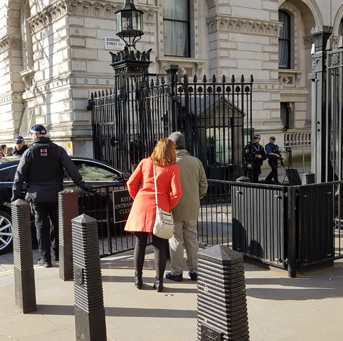The latest in an occasional series on doing security in the past, based on freely downloadable documents from the National Archives at Kew in west London. This is a tale of two VIP visitors, on either side of the Second World War; only one actually made his visit.
First, chronologically, is file FO-954-10A-271, a note by Foreign Office official Oliver Stanley, dated January 31, 1938. Lord Derby, it began, had suggested to the Foreign Secretary, Anthony Eden, that Derby invite ‘General Goering to stay with him for the Grand National’, the Liverpool annual race meeting.
Stanley wrote: “Mr Eden is rather inclined to favour a visit of this kind, ie a private visit to Knowsley [Lord Derby’s family seat in Liverpool] for a sporting event, provided the Home Secretary [then Samuel Hoare] thinks we should not be running any serious risk of seeing hostile demonstrations organised against the General.
“If General Goering passed through or stopped in London on the way to or from Knowsley, there might, of course, be a greater risk of this than if it could be arranged that he should travel direct to and from Knowsley by air.
“Before answering Lord Derby, Mr Eden would be grateful to learn what risk there is, in the opinion of the Home Secretary, of hostile demonstrations against General Goering whether in the streets of London or on the course at Aintree, and to what extent that risk would be diminished if it should be possible to arrange for the General to go to and from Knowsley by air without touching London (except perhaps for a call at Croydon).”
As an aside, Croydon was where, in the days before Heathrow Airport, London’s main airport for the Continent was. Passengers gathered near Victoria railway station in central London in what is now the head office of the National Audit Office before being coached to the actual airport outside the city.
Harvey’s memo ended: “Mr Eden would also be glad to be advised whether, from the point of view of the General’s own security, there is any reason to think that a visit by him to this country in present circumstances would be undesirable.”
The document is an interesting sign of how government thought in terms of securing VIPs, not wanting the embarrassment of ‘hostile demonstrations’, let alone attempts on their life, such as the assassination of King Alexander of Yugoslavia in Marseilles on a visit to France in 1934. The security thinking was sound; put distance between any ‘hostiles’ by avoiding cities altogether, and ship, road and rail travel between cities, by flying in. Such is the norm now for international summits and the September 1938 meeting of Neville Chamberlain and Hitler in Germany that led to the infamous ‘peace in our time’ Munich agreement.
Nothing came of the idea; Eden resigned as Foreign Secretary a few weeks later, disagreeing with Chamberlain over whether or how to appease the fascist powers Italy and Germany. Hermann Goering, number two in the Nazi regime to Hitler, killed himself, to avoid being hung at the Nuremberg war crimes trials, in 1946.
Talking of Yugoslavia, the postwar Communist ruler Tito visited London in March 1953, arriving by sea. Security was remarked on by The Times as ‘elaborate’ by police, seldom allowing the public near Tito. The visit was sensitive as the first to the UK by a Communist head of state; besides, plenty of people wanted Tito dead, not only as a Communist but after the vicious civil war between 1941 and 1945 between Serb and Croat, stirred up by Italian and German occupiers.
As Tito came up the Thames by launch to step onto British soil at Westminster Pier to be greeted by the Prime Minister Winston Churchill, the Duke of Edinburgh and the Foreign Secretary (Eden again), all the bridges that Tito passed under were out of bounds to the public, in case of an outrage, and police launches were on patrol. When Tito was taken by car into New Scotland Yard, a magnesium flare went off, and as The Times put it, ‘police immediately began to make their inquiries’.
During Tito’s five-day visit security was equally strict – Tito going to the usual places, 10 Downing Street, having lunch with the Queen at Buckingham Palace, and attending London County Council, then at County Hall across the river from Parliament; the British Museum, the Tower of London, and the Yugoslav Embassy in Kensington; Tito actually stayed at the White Lodge in Richmond Park in west London.
As a sign of differing attitudes to risk, at Duxford, at an air display in honour of Tito, two RAF Meteor jet planes crashed, killing the pilots. The programme was ‘slightly curtailed’.
As another sign of the times; when the PM gave a dinner party for Tito, The Times reported ‘rigid security regulations’; police cordoned off Downing Street and set up lines across the pavement in Whitehall. Since IRA acts of terror, it became the norm for Downing Street to be closed to the public, pictured; before, sight-seers could go to the steps of Number 10.
Other security features of the visit have become commonplace; details of the itinerary not being released beforehand (rather than giving assassins and trouble-makers advance notice of where and when to position themselves to do most harm), and police motorcycle outriders and cars escorting the VIP through the streets, stopping traffic from getting near the VIP, to avoid a security risk – infamous assassinations from King Alexander to Archduke Ferdinand in Sarajevo in 1914 being by a bystander into a car.










